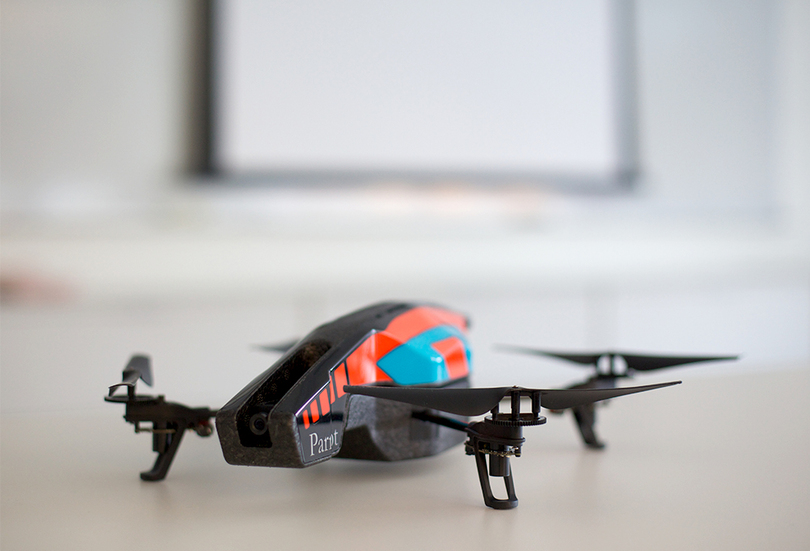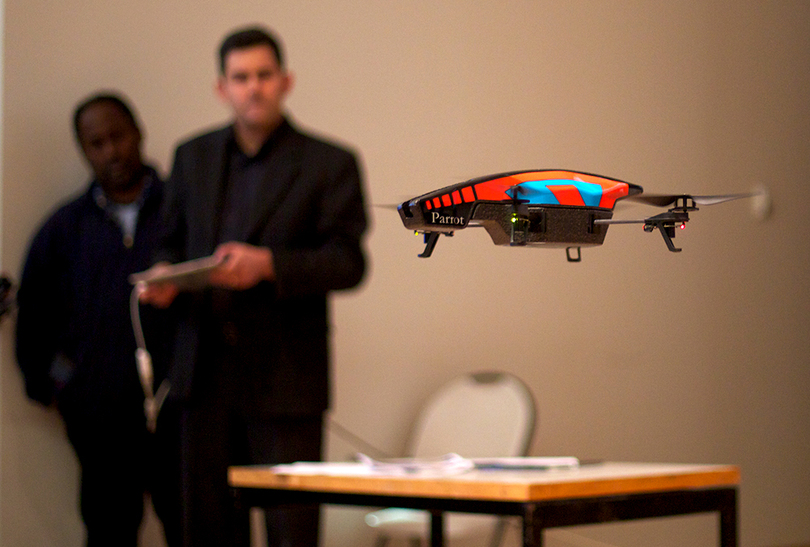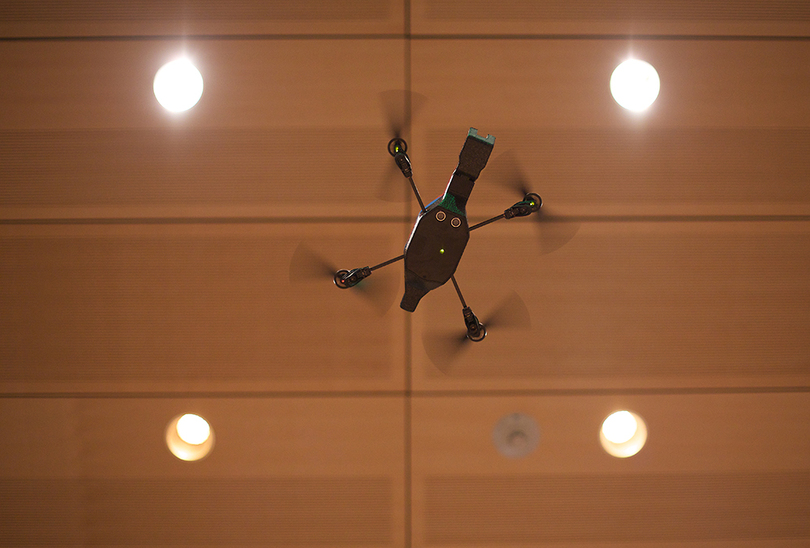Brave new world: Professor displays drone, encourages students to explore controversial future
The flying object was placed on a table stacked with fliers in front of an auditorium of onlookers. The object began to buzz, spinning its four identical propellers into a blur.
The concealed video camera inside the flying object projected its view of the audience sitting in the Joyce Hergenhan Auditorium onto a projection screen. People watched, mesmerized. One person waved at himself.
“It’s not just going to be some kind of trend. My prediction is five years from now, we’re not even going to be talking about this because it will be normal,” said Dan Pacheco.
Pacheco, a professor at the S.I. Newhouse School of Public Communications, stated that he foresees the near future of multimedia journalism to include a current controversial method of photography: drones.
Though drones are easily accessible, with products available at Toys R Us and on Amazon.com, it is near impossible for anyone to gain licensing rights for commercial use.
New to Syracuse University since August, Pacheco was hired to Newhouse as the Chair of Journalism Innovation. He said he is in charge of introducing new innovations to Newhouse students and faculty and to get people thinking.
A room full of media-savvy students, faculty and community members munching on complimentary Roly Poly sandwiches actively listened to Pacheco’s presentation on the prospect of drones used in journalism Tuesday in Newhouse III.
He began his PowerPoint presentation by diffusing the general public’s opinion of what a drone actually is. He explained that, for journalistic purposes, his definition of a drone is a relatively small, manually controlled device, much like a remote-control airplane, but with a video camera attached.
After an hour-long presentation in a classroom, Pacheco announced with much anticipated excitement: “You all ready to fly a drone?”
The classroom of people moved to the Herg, where Pacheco demonstrated the awaited feat, featuring an orange and blue drone that SU purchased with Pacheco’s supervision — although he said the colors were just a coincidence.
After the demonstration, Pacheco asked the room at large for any volunteers wishing to give the controls a try. Three students lined up, but unfortunately the drone had another agenda. Refusing to reconnect to the Wi-Fi, it remained on the ground.
Sophomore television, radio and film major Nate Carlson said he was surprised the event’s turnout consisted mainly of local news media and only a handful of students. Carlson said he thinks drones have a future in the film industry.
“I can see myself using them to film aerial shots for movies,” he said. “It would make it much easier.”
Still, he said he thinks using drones in journalism is a scary thought, and pictures drones sneakily flying around taking videos.
In Pacheco’s presentation, he addressed this thought, saying it is one the government is also scared of.
In fact, a national bill was recently signed into law by President Barack Obamaregarding the commercial usage of drones titled “The Federal Aviation Administration (FAA) Modernization and Reform Act of 2012,” commonly called The Drone Act. It states that the FAA needs to set strict guidelines to make it legal to fly commercialized drones in federal air space by Sept. 30, 2015.
Pacheco said drones are in demand for multiple reasons, including police surveillance, monitoring of farm crops and personal photography. As far as journalism goes, the sky is the limit with possibilities. Difficult shots that generally require a helicopter to get footage can easily be replaced with drones, said Pacheco.
Drones are also much more cost-efficient and keep humans out of harm’s way, in instances such as shooting footage for forest fires, storm damage, free speech protests or even sporting events.
With journalism, Pacheco stressed that ethics are a major concern.
Even so, Dave Tobin, a staff reporter from The Post-Standard who attended the presentation, said he believes there is definitely a place for drones in the journalism world. He said he thinks The Post-Standard will undoubtedly invest in a drone or two in the future.
At the end of Pacheco’s presentation, he announced a contest for SU students to win a drone.
“There are two different competitions. One is to come up with the best story idea that would use drone footage. Then, the one that we think has the most promise, we’ll give that person a drone,” Pacheco said.
The second competition gives students with programming skills the opportunity to create an application to go along with a drone. The deadline for submissions is Feb. 23.
After onlookers left the auditorium, Pacheco picked up the fliers for the contest that had scattered onto the floor by the drone’s propellers. He had forgotten to pass them out. Soon, however, they will be hanging up around campus.
Published on January 23, 2013 at 11:45 pm
Contact Kristin: klross01@syr.edu | @kriskross22








